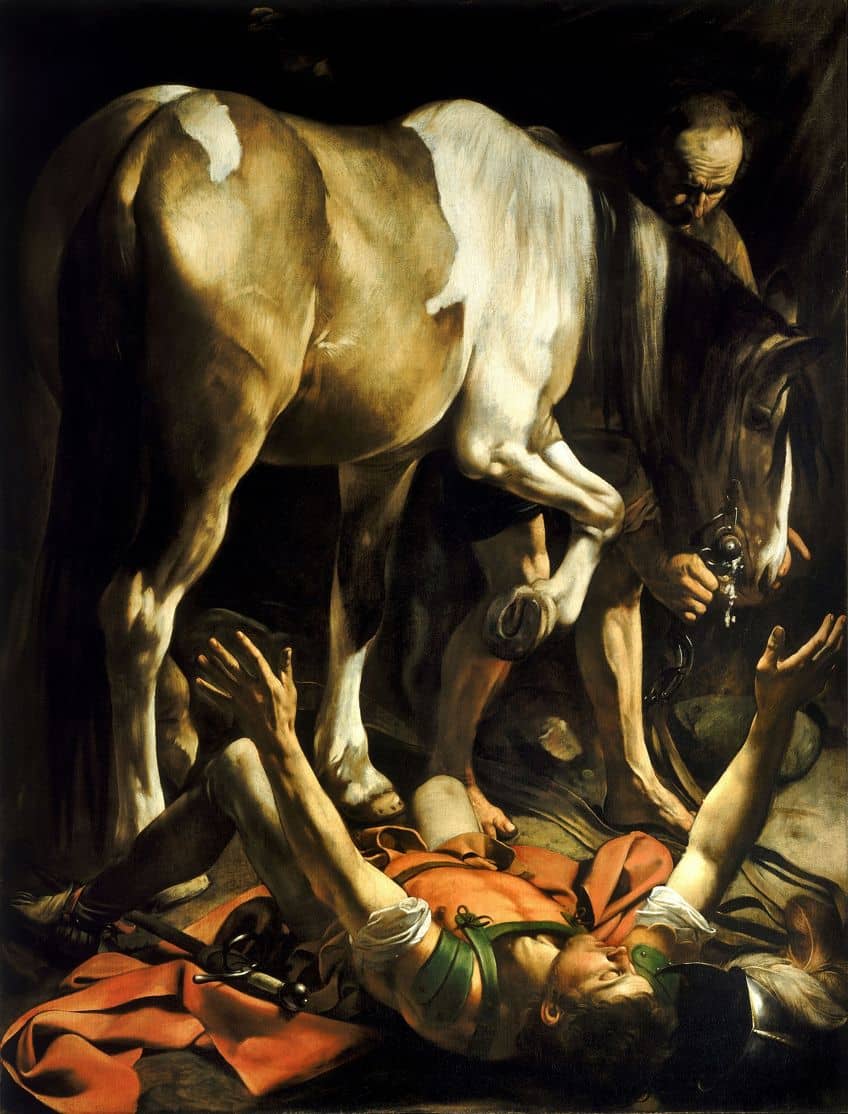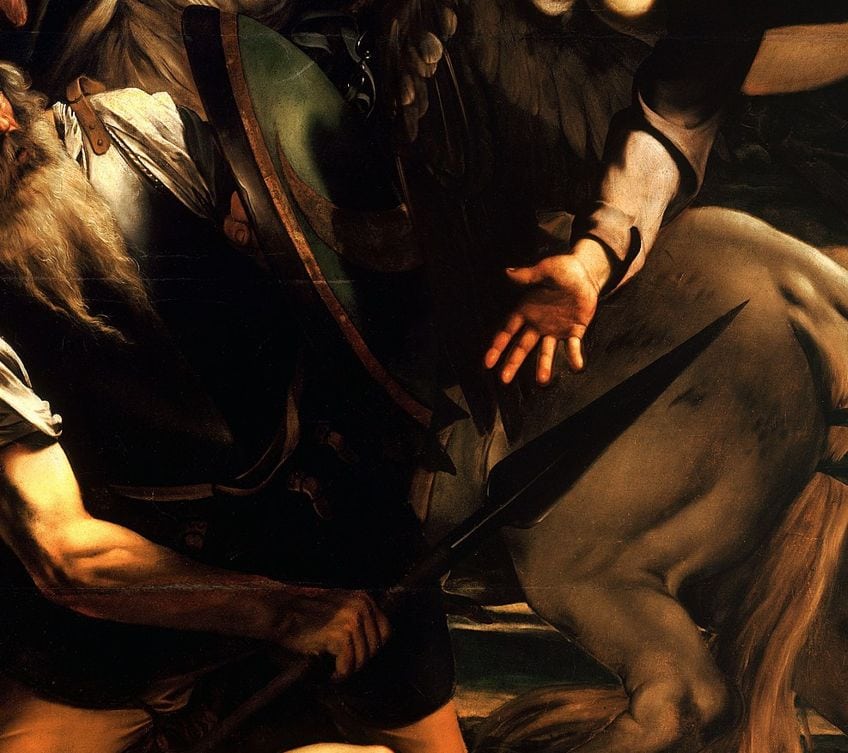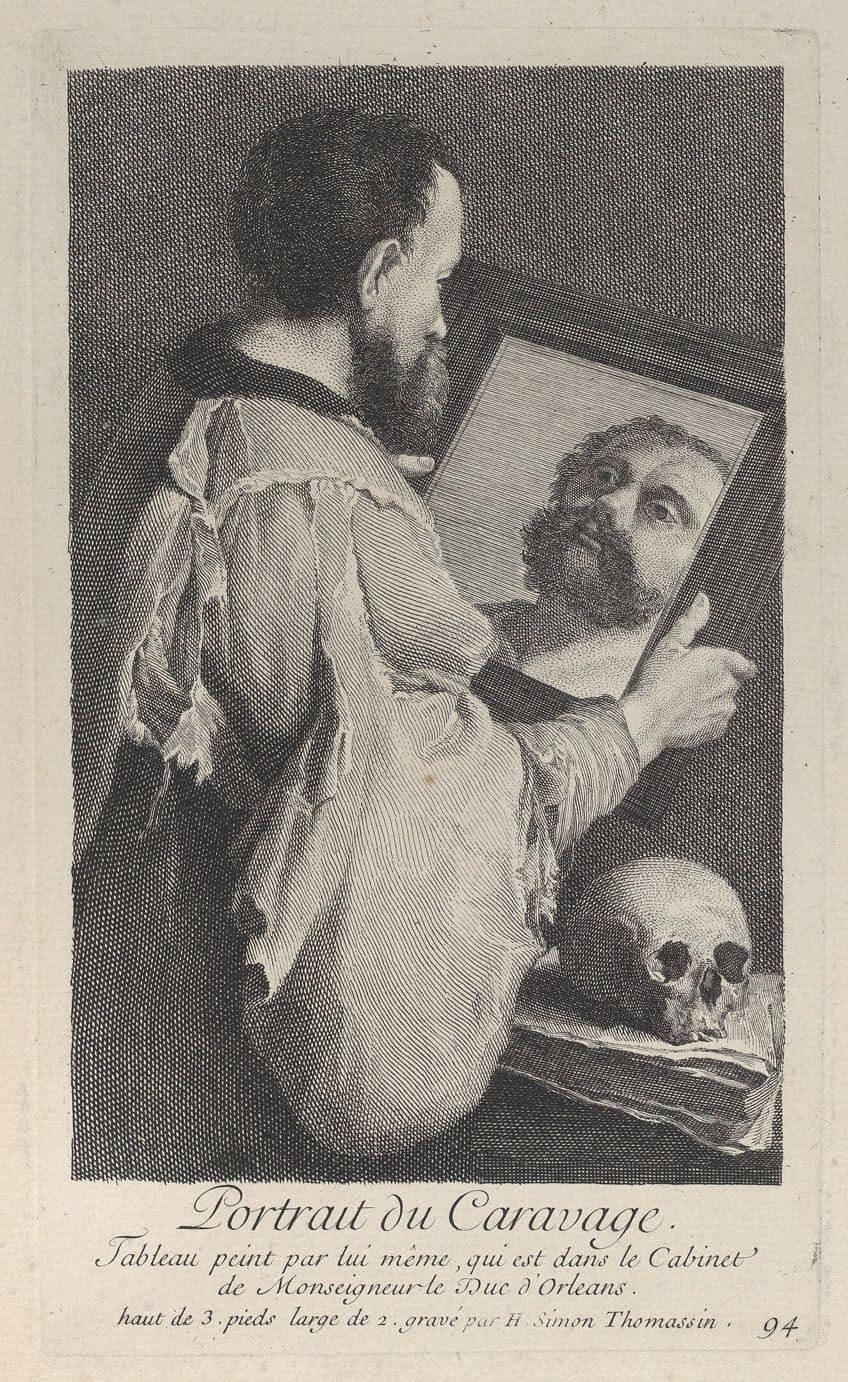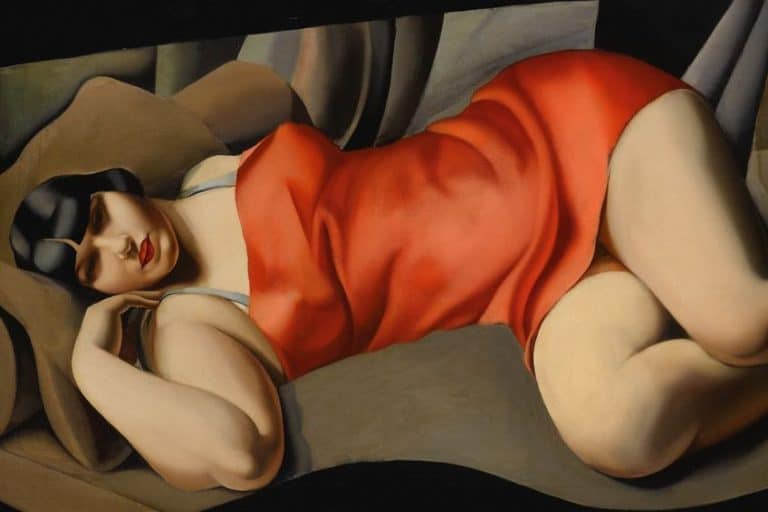“Conversion of St Paul” by Caravaggio – An Analysis
The Baroque artist famously known as Caravaggio created two paintings around the theme of Saint Paul’s conversion to Christianity. This article will discuss these paintings in more detail and explore why the artist had to paint a second version. Read more in the following Conversion of St Paul (c. 1600 – 1601) analysis.
Artist Abstract: Who Was Caravaggio?
Michelangelo Merisi da Caravaggio was born In Milan on September 29, 1571, and died on July 18, 1610. His youth was also spent in the town called Caravaggio in Lombardy, Italy. His studies included the tutelage of the artists Simone Peterzano and Giuseppe Cesari. His main painting style included the technique known as tenebrism, where he focused on dramatically light and dark areas of his paintings. He was also known for utilizing models like prostitutes and people who lived under poor conditions. Some of his most famous artworks include Young Bacchus (1593), Medusa (1597 – 1598), and The Calling of St Matthew (1599 – 1600).

Conversion of St Paul (c. 1600 – 1601) by Caravaggio in Context
| Artist | Michelangelo Merisi da Caravaggio (1571 – 1610) |
| Date Painted | c. 1600 – 1601 |
| Medium | Oil on cypress panels |
| Genre | Religious painting |
| Period/Movement | Baroque art |
| Dimensions (centimeters) | 237 x 189 |
| Series/Versions | This is the second version about the conversion of Paul the Apostle. It is also part of a set with another painting about Saint Peter’s crucifixion. |
| Where Is It Housed? | Odescalchi Balbi Collection, Rome, Italy |
| What It Is Worth | The price is uncertain |
In the Conversion of St Paul analysis below you will read more about the Baroque painter, known as Caravaggio, two paintings around the theme of Paul the Apostle’s conversion from the story in the New Testament of the Bible. A formal analysis will focus on one of these paintings, namely the Conversion of St Paul (c. 1600 – 1601) which is kept in a private collection called the Odescalchi Balbi Collection in Rome, Italy.
Contextual Analysis: A Brief Socio-Historical Overview
Caravaggio was commissioned in 1600 by Monsignor Tiberio Cerasi to create two paintings for the Cerasi Chapel (otherwise also known as the Chapel of the Assumption), which is part of the Basilica of Santa Maria del Popolo in Rome, Italy. Cerasi held the position of Treasurer-General to Pope Clement VIII and purchased the patronage rights of the chapel in July 1600 from the previous owners who were reportedly Augustinian friars. To redecorate the chapel, Cerasi commissioned Caravaggio, along with the Italian painter Annibale Carracci, to create the chapel’s paintings.
Carracci painted the oil on wood altarpiece titled The Assumption of the Virgin (1600 – 1601) and Caravaggio painted the two side panel paintings, also oil on wood.
These were about the patron saints, Saint Peter, notably about his crucifixion, titled Crucifixion of Saint Peter (c. 1600 – 1601), and Saint Paul, about his conversion, titled Conversion of St Paul (c. 1600 – 1601). Caravaggio painted new versions of both above-mentioned paintings, which are titled Conversion on the Way to Damascus (1601) and Crucifixion of Saint Peter (1601), because Cesari reportedly rejected the first iterations. However, the reasons for this rejection are unclear, and subsequently, the Catholic cardinal, Giacomo Sannesio, reportedly acquired Caravaggio’s first two versions after they were not being utilized in the chapel.

More About the Story of Paul’s Conversion
The story about Saint Paul’s conversion originates from the Book of Acts in the New Testament in the Bible. Saint Paul’s other names include Saul of Tarsus as well as Paul the Apostle. Before his conversion, he was infamous for his dislike of Christians and was part of their persecution.
On one occasion, Saul traveled to Damascus to capture newly converted Christians and take them to Jerusalem, but on his way there, Jesus Christ appeared to him, which caused him to fall to the ground, and he was blinded for three days.
Jesus Christ spoke to Saul and asked why Saul was persecuting Him, and then ordered Saul to go to the city where he met the disciple Ananias who restored his sight again. Saul also started preaching about Jesus Christ. He was later referred to as Paul, which is the Greek name; Saul is the Hebrew name.
Formal Analysis: A Brief Compositional Overview
The formal analysis will discuss the painting titled Conversion of St Paul, which was painted around 1600 to 1601. It is part of the Odescalchi Balbi Collection in Rome, Italy. This was the first version that Caravaggio painted, but there will be mention of the second version, which is now at the Santa Maria del Popolo in Rome, Italy. A visual description will discuss the subject matter in more detail and then look at Caravaggio’s art techniques through the lenses of the art elements like color, texture, line, shape, form, and space, which are typically known as what builds a visual composition.

Subject Matter: Visual Description
The scene is filled with action and emotion, from Paul’s tense and spiritual moment in the foreground, the older man and horse filling the middle ground to Jesus Christ, and the angel in the background reaching out to Paul. Let us take a closer look. The Conversion of St Paul, by Caravaggio, depicts a dramatic moment when Saint Paul, who was also named Saul of Tarsus, is hit by a blinding confrontation by Jesus Christ, the latter is depicted in the top right corner of the composition, reaching out to Saul. Next to Jesus Christ’s figure, on his right side, and holding onto him, is an angel with what appears to have black wings.
The bearded Paul is pictured lying on the ground in the foreground of the composition.
He is partially lying or leaning on his right side, and his body is more faced towards us, the viewers. Both his hands are held over his eyes, his right hand is over his left hand. He is also partially naked, mainly with coverings around his waist. Standing behind Paul is a male figure holding a shield in his left hand and a spear in his right hand. His right foot is resting on Paul’s helmet, which has fallen off his head and is lying on the ground next to him.
This tall man appears to be in a defensive position, blocking the figures of Jesus Christ and the angel. There is also a white horse further into the background of the composition, which is facing the left with its head reared towards the two figures mentioned above, and its back left hoof is raised. The surroundings are vague, but it appears to be outdoors due to some vegetation to the right edge near Christ’s hands and to the left, including rocky ground. There appear to be three steps of a stone stairway visible in the background.

Caravaggio’s Second Version: Conversion on the Way to Damascus
It is worthwhile to also look at Caravaggio’s second version of Saint Paul’s conversion painting. While the subject matter was depicted as simpler and quieter, the artist did not detract from the emotional dramatism that was so characteristic of his artworks. The only figures in this composition are Saint Paul, who fills the foreground space, and the older man. Saint Paul is lying on the ground on his back with both arms outstretched and he appears younger than the version of him in Caravaggio’s first painting.
Saint Paul’s face appears less anguished by what is happening to him, and his eyes are closed as if he is entranced by his divine state.
He is also more clothed, appearing in garb that resembles a Roman soldier’s uniform. The horse is more visible in this version, which is facing towards the right direction and controlled by an older man who is visible in the background. The figure of Jesus Christ and the angel is not included in this version, but golden rays of light are evident along the right edge of the composition, symbolizing the divine communion with Saint Paul.

Color and Value
With a blend of skin tones, reds, greens, browns, and black, Caravaggio depicted this first version of the Conversion of St Paul with contrasts of light and dark, or the value of the colors, that all create emphasis and dramatism. This technique has also been described as tenebrism and became one of the defining characteristics of the artist’s painting style.
There is light on the figure of Saint Paul, which highlights him as a focal point.
This unknown light source is further depicted in the other figures, illuminating their presence in the composition and the action taking place between them. Notice the light source on the steps in the background, which leads to the question of where they lead to. Contrasted with the lighter areas, there are also dark, almost black, areas in this composition. For example, notice the dark shadows on the figure of Jesus Christ, as well as on the figure of the old man standing behind Saint Paul.

Texture
Caravaggio was known for his naturalistic subject matter, which the composition of the Conversion of St Paul painting depicts through implied textures. For example, the smooth, but gritty texture of the stone stairway in the background, the soft texture of Saint Paul’s beard, or the horse’s long tail. Additionally, notice the men’s and horse’s muscular definitions as they tense in their postures.

Line
The Conversion of St Paul by Caravaggio consists of a variety of types of lines, including diagonal, horizontal, and vertical, but also straight, curved, irregular, and short lines, all of which combine to create, or delineate, a naturalistic composition. There are also directional lines created through other art elements like color and value, which direct your, the viewer, gaze towards the focal point and ultimately, the theme of the painting, which is about Saint Peter’s spiritual or divine intervention by Jesus Christ.
The light and dark areas direct your gaze, for example, the light source on Saint Peter.
Other objects like the spear, which is partially pointed upwards, almost towards Jesus Christ, lead your gaze towards Him, and furthermore, Jesus Christ’s outstretched right arm also directs your gaze towards Paul, creating another directional line implied through the subject matter’s positioning.

Shape and Form
There are organic, otherwise also termed as naturalistic, shapes and forms in Conversion of St Paul by Caravaggio. These consist of the human and animal figures present including the irregular shapes of the visible vegetation in the composition. There are some geometric shapes visible in the triangular tip of the spear or the circular shapes of the shields.

Space
Caravaggio depicted a full compositional space, with the figure of Saint Paul foreshortened in the foreground to create a sense of depth or three-dimensionality on the flat and two-dimensional canvas.
Depth is further created through the art elements of color and contrasting values of light and dark.

Caravaggio and an Artistic Conversion
Caravaggio was one of the foremost Baroque artists of his time and well-known for how he mastered and maneuvered his painting style between contrasts of light and dark, which is a technique known as tenebrism. This became one of his trademarks as seen in the above Conversion of St Paul analysis.

Caravaggio painted with a heightened sense of realism and was known to use models like beggars or prostitutes. However, regardless of how the Baroque artist chose to paint his compositions, one fact is certain; his artistic acumen and skill had the catalytic potential to create artistic conversions in all of us.
Frequently Asked Questions
Who Painted the Conversion of St Paul Paintings?
The Baroque painter, Caravaggio, painted the Conversion of St Paul (c. 1600 – 1601), including the Conversion on the Way to Damascus (1601). He was commissioned in 1600 by Monsignor Tiberio Cerasi, who wanted him to create a painting about Paul the Apostle’s conversion and the crucifixion of Saint Peter titled the Crucifixion of Saint Peter, which he did in 1601.
Where Are the Conversion Paintings by Caravaggio?
Conversion of St Paul (c. 1600 – 1601) is part of the Odescalchi Balbi Collection in Rome, Italy. The Conversion on the Way to Damascus (1601) is located at the Santa Maria del Popolo in Rome, Italy.
Who Commissioned the Conversion of St Paul by Caravaggio?
Monsignor Tiberio Cerasi commissioned Caravaggio in 1600 to paint two paintings for the Cerasi Chapel in Rome, Italy. The themes were to be about Saint Paul’s conversion and Saint Peter’s crucifixion.
Alicia du Plessis is a multidisciplinary writer. She completed her Bachelor of Arts degree, majoring in Art History and Classical Civilization, as well as two Honors, namely, in Art History and Education and Development, at the University of KwaZulu-Natal, South Africa. For her main Honors project in Art History, she explored perceptions of the San Bushmen’s identity and the concept of the “Other”. She has also looked at the use of photography in art and how it has been used to portray people’s lives.
Alicia’s other areas of interest in Art History include the process of writing about Art History and how to analyze paintings. Some of her favorite art movements include Impressionism and German Expressionism. She is yet to complete her Masters in Art History (she would like to do this abroad in Europe) having given it some time to first develop more professional experience with the interest to one day lecture it too.
Alicia has been working for artincontext.com since 2021 as an author and art history expert. She has specialized in painting analysis and is covering most of our painting analysis.
Learn more about Alicia du Plessis and the Art in Context Team.
Cite this Article
Alicia, du Plessis, ““Conversion of St Paul” by Caravaggio – An Analysis.” Art in Context. November 16, 2023. URL: https://artincontext.org/conversion-of-st-paul-by-caravaggio/
du Plessis, A. (2023, 16 November). “Conversion of St Paul” by Caravaggio – An Analysis. Art in Context. https://artincontext.org/conversion-of-st-paul-by-caravaggio/
du Plessis, Alicia. ““Conversion of St Paul” by Caravaggio – An Analysis.” Art in Context, November 16, 2023. https://artincontext.org/conversion-of-st-paul-by-caravaggio/.











